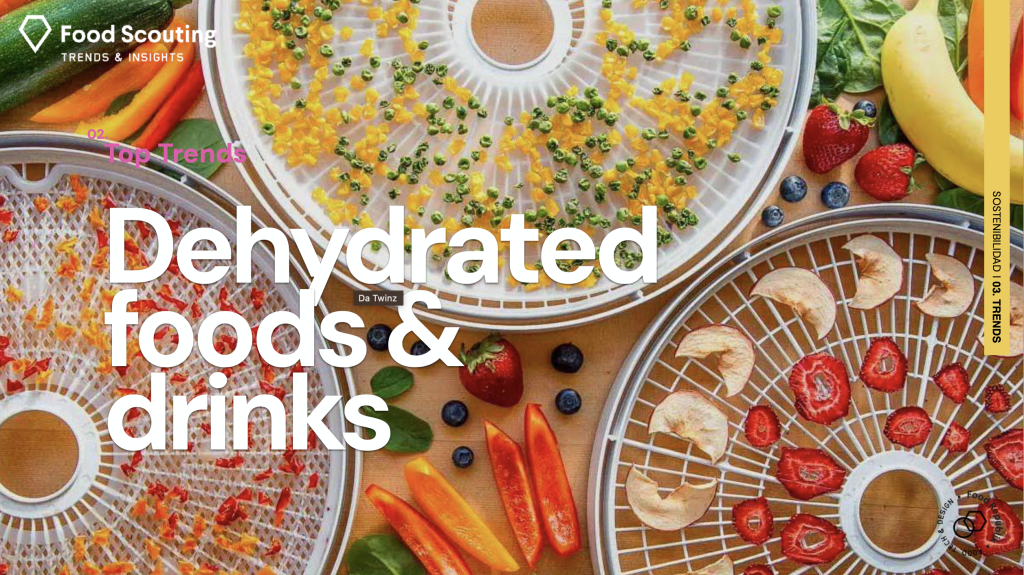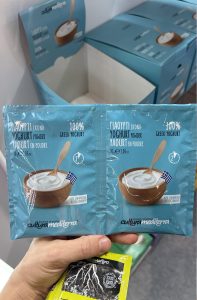Food trend: the rise of dehydrated products

Context: The challenge of waste and the rise of dehydrated products.
It is estimated that approximately one third of global food production is wasted, often due to microbiological spoilage or poor storage management. On the other hand, today’s contact demands solutions that not only reduce waste, but also optimize transportation and use less additives and packaging material.
Dehydrated food is emerging as an innovative solution in the food industry. With a projected growth rate of 6.77% CAGR between 2023 and 2028, this segment is positioned as the ideal alternative to preserve nutrients, reduce food waste and optimize transportation costs. This article explores how new technologies and the growing demand for healthier and more sustainable products are transforming the food landscape.
Dehydrated products: what are they and why are they the new food trend?
What does “dehydrated” mean in the food industry?
Dehydration of foods, by reducing water activity, slows microbial growth and enzymatic degradation, significantly extending shelf life, allowing better utilization of food while preserving the nutritional properties of the food.
From ancestral method to star of modern consumption
Dehydrated foods have many other advantages, as they allow:
- Take advantage of seasonal surpluses that would otherwise be lost.
- Reduce postharvest losses, especially in fruits, vegetables and perishable products.
- Facilitate redistribution and storage in contexts with little cold infrastructure.
Factors driving its global popularity
Dehydration brings logistical and functional advantages:
- Reduced weight and volume: facilitates transportation and reduces storage costs.
- Increased seasonal availability: allows year-round access to certain foods without the need for refrigeration.
- Industrial and domestic versatility: they can be easily rehydrated and, in many cases, have a higher concentration of flavor and nutrients.
Overall, it is a key technology for more sustainable and resilient food systems.
Main technologies that are revolutionizing food dehydration
Advances in dehydration technologies have been key to boosting this sector. Innovations include:
Freeze Drying (Freeze Drying)
The food is frozen and then the water is removed by sublimation (direct passage from ice to steam). It preserves the structure, color, flavor and nutrients very well.
Vacuum Drying (Vacuum Drying)
It is carried out at low temperatures in a vacuum environment, which reduces heat stress and helps preserve sensitive compounds such as vitamins and flavors.
Microwave Drying (Microwave Drying)
It uses microwaves to heat the water inside the food, accelerating drying from the inside to the outside. Its use is limited at the industrial level, although it is growing.
Vacuum technology with radiant energy (EnWave Radiant REV™)
Patented and still expanding technology combines microwave with vacuum for fast, uniform and low temperature dehydration. Minimizes loss of sensory and nutritional quality.
Infrared Drying (Infrared Drying)
It uses infrared radiation to heat the surface of the food, which accelerates drying. It is energy efficient and can reduce process times and costs.
These technologies significantly reduce waste and transportation costs, opening up new “on the go” consumption moments.
Functional and nutritional benefits of dehydrated products
Dehydrated products have many advantages
Good nutritional and sensory preservation
Many techniques make it possible to maintain much of the nutritional value, flavor and aroma of the original food.
Reduction of food waste
They help alleviate the overall amount of food waste globally, especially in fruits, vegetables and fresh produce.
Logistics optimization
Lower weight and volume facilitate transportation, reduce costs and improve efficiency in the supply chain.
Reduced need for preservatives
Its low water content acts as a microbiological barrier, reducing the amount of additives.
Adaptation to new consumption moments
Practical for modern lifestyles, healthy snacks, “on the go” foods or situations where refrigeration is not available.
These opportunities position dehydrated food not only as a growing trend, but also as a comprehensive solution to today’s food industry challenges.
Cases of innovation that are transforming the industry
In our scouting at trade fairs around the world we have seen the growing phenomenon of dehydration with innovative proposals.
Companies and Startups that are changing the rules of the game

EARNEST FOODS (US) – Smashed Avocado
This company has revolutionized the market with its dehydrated avocado smashed avocado, offering a practical option with a long shelf life for the modern consumer, without sacrificing nutritional quality.

AMARA (US) – Dehydrated Babyhood
Amara stands out in the baby food segment, developing dehydrated products that guarantee optimal nutrition in early stages of development, facilitating the preparation of healthy meals for babies.

CULTURA MEDITERRA (GR) – Dehydrated products
The Greek brand Cultura Mediterrra offers a range of products including dehydrated yogurt, sauces, hummus and tzatziki. These products combine Mediterranean tradition with technological innovations, offering foods with longer shelf life and lower logistics costs.

GATORADE (US) – Moisturizing Drink Powder
The giant PepsiCO has converted its legendary sports drink Gatorade into a dehydrated format to compete with a growing number of brands offering this format and to make a commitment to sustainability.
Other growing categories with dehydrated formats: new formats, textures and consumption experiences
Dehydration has enabled the creation of new formats and textures, fusing convenience with sophistication. Innovative snacks and gourmet products offer intense flavors and nutritional benefits in lighter, easy-to-carry options, adapting to today’s lifestyles.
Dehydrated beverages and snacks.
One category that is innovating a lot is beverages: sports nutrition powders, proteins, electrolytes, vegetable milks, for example oat powder, dehydrated juices and smoothies, avoiding not only transporting water and heavy packaging but also creating new moments of consumption.
Dehydration is giving rise to many new ways of consuming fruits and vegetables – whole fruit and vegetable chips, dehydrated purees turned into snacks, even salads.
Dehydrated meat snacks – the jerky
The macro trend of incorporating more animal protein can also be found in dehydrated format – meat, fish in snacking format, as jerky or as biltong as the Australians call it.
The role of dehydration in signature gastronomy
In haute cuisine, dehydration opens up new possibilities to play with textures and flavors. It preserves nutrients and aromas, offering versatile ingredients that allow chefs to create unique and avant-garde experiences.
Emerging trends in dehydrated products consumption
Dehydrated food is positioned as a disruptive trend in today’s market, driven by the fusion with superfoods and functional formats that maximize both the nutritional profile and the versatility of the product. At the same time, dehydrated snacks have become an option that combines the convenience of quick consumption with the sophistication of gourmet proposals, adapting to modern lifestyles. In addition, generational demand and changes in consumption, reflecting a growing awareness of health and sustainability, reaffirm that this segment not only transforms the way food is consumed, but also sets the course for a more innovative food future, adapted to the needs of an increasingly demanding public.
This information is part of the report 9 Trends for 2025If you want to learn more about this topic or other innovation categories, please contact us! If you have an innovation challenge, we have cases and information that will help you make strategic decisions.



